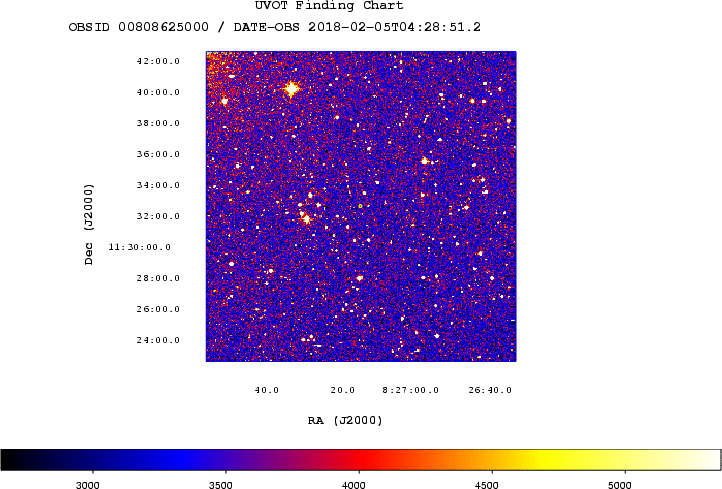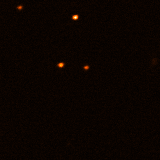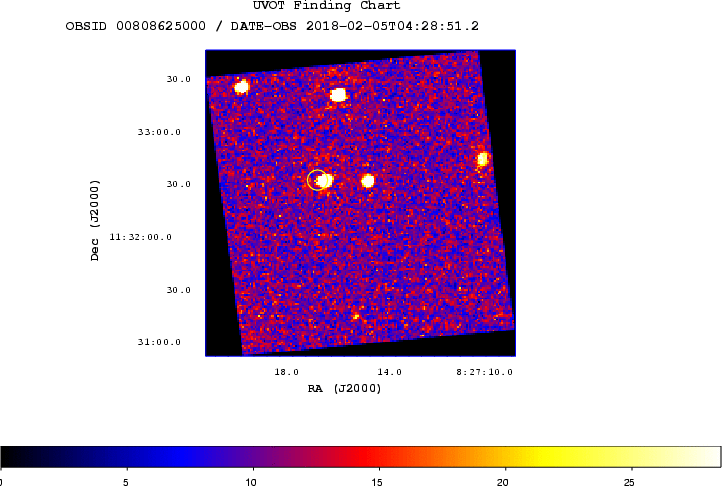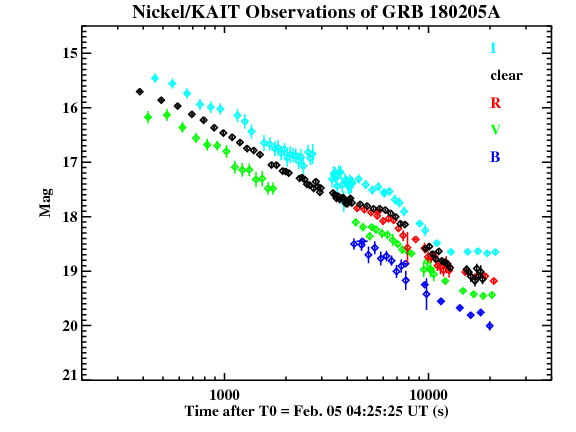(All information courtesy of the instrument teams.)
![]() Previous IAU Circulars
Previous IAU Circulars
TITLE: GCN/FERMI NOTICE
NOTICE_DATE: Mon 05 Feb 18 04:25:52 UT
NOTICE_TYPE: Fermi-GBM Flight Position
RECORD_NUM: 48
TRIGGER_NUM: 539497530
GRB_RA: 99.517d {+06h 38m 04s} (J2000),
99.957d {+06h 39m 50s} (current),
98.297d {+06h 33m 11s} (1950)
GRB_DEC: +64.567d {+64d 34' 00"} (J2000),
+64.550d {+64d 32' 59"} (current),
+64.610d {+64d 36' 35"} (1950)
GRB_ERROR: 19.87 [deg radius, statistical plus systematic]
GRB_INTEN: 123 [cnts/sec]
DATA_SIGNIF: 4.60 [sigma]
INTEG_TIME: 4.096 [sec]
GRB_DATE: 18154 TJD; 36 DOY; 18/02/05
GRB_TIME: 15925.39 SOD {04:25:25.39} UT
GRB_PHI: 190.00 [deg]
GRB_THETA: 150.00 [deg]
DATA_TIME_SCALE: 4.0960 [sec]
HARD_RATIO: 2.54
LOC_ALGORITHM: 3 (version number of)
MOST_LIKELY: 69% GRB
2nd_MOST_LIKELY: 29% Generic SGR
DETECTORS: 0,0,0, 0,0,0, 0,0,1, 0,0,1, 0,0,
SUN_POSTN: 318.77d {+21h 15m 05s} -15.95d {-15d 56' 43"}
SUN_DIST: 124.75 [deg] Sun_angle= -9.4 [hr] (East of Sun)
MOON_POSTN: 197.71d {+13h 10m 50s} -2.47d {-02d 27' 58"}
MOON_DIST: 95.55 [deg]
MOON_ILLUM: 74 [%]
GAL_COORDS: 150.67, 22.92 [deg] galactic lon,lat of the burst (or transient)
ECL_COORDS: 95.42, 41.31 [deg] ecliptic lon,lat of the burst (or transient)
LC_URL: http://heasarc.gsfc.nasa.gov/FTP/fermi/data/gbm/triggers/2018/bn180205184/quicklook/glg_lc_medres34_bn180205184.gif
COMMENTS: Fermi-GBM Flight-calculated Coordinates.
COMMENTS: This trigger occurred at longitude,latitude = 265.62,-24.10 [deg].
COMMENTS: The LC_URL file will not be created until ~15 min after the trigger.
TITLE: GCN/FERMI NOTICE
NOTICE_DATE: Mon 05 Feb 18 04:26:02 UT
NOTICE_TYPE: Fermi-GBM Ground Position
RECORD_NUM: 57
TRIGGER_NUM: 539497530
GRB_RA: 134.430d {+08h 57m 43s} (J2000),
134.673d {+08h 58m 41s} (current),
133.759d {+08h 55m 02s} (1950)
GRB_DEC: +8.640d {+08d 38' 24"} (J2000),
+8.569d {+08d 34' 10"} (current),
+8.834d {+08d 50' 01"} (1950)
GRB_ERROR: 8.68 [deg radius, statistical only]
DATA_SIGNIF: 9.50 [sigma]
DATA_INTERVAL: 1.024 [sec]
GRB_DATE: 18154 TJD; 36 DOY; 18/02/05
GRB_TIME: 15925.39 SOD {04:25:25.39} UT
GRB_PHI: 186.00 [deg]
GRB_THETA: 89.00 [deg]
E_RANGE: 44.032 - 279.965 [keV]
LOC_ALGORITHM: 4153 (Gnd S/W Version number)
SUN_POSTN: 318.77d {+21h 15m 05s} -15.95d {-15d 56' 42"}
SUN_DIST: 171.61 [deg] Sun_angle= -11.7 [hr] (East of Sun)
MOON_POSTN: 197.71d {+13h 10m 50s} -2.47d {-02d 28' 00"}
MOON_DIST: 63.80 [deg]
MOON_ILLUM: 74 [%]
GAL_COORDS: 219.86, 31.95 [deg] galactic lon,lat of the burst (or transient)
ECL_COORDS: 134.37, -8.22 [deg] ecliptic lon,lat of the burst (or transient)
LC_URL: http://heasarc.gsfc.nasa.gov/FTP/fermi/data/gbm/triggers/2018/bn180205184/quicklook/glg_lc_medres34_bn180205184.gif
POS_MAP_URL: http://gcn.gsfc.nasa.gov/notices_f/gbm_gnd_loc_map_539497530.fits
COMMENTS: Fermi-GBM Ground-calculated Coordinates.
COMMENTS: This Notice was ground-generated -- not flight-generated.
COMMENTS: The LC_URL file will not be created/available until ~15 min after the trigger.
COMMENTS: The POS_MAP_URL file will not be created/available until ~1.5 min after the notice.
TITLE: GCN/FERMI NOTICE
NOTICE_DATE: Mon 05 Feb 18 04:27:12 UT
NOTICE_TYPE: Fermi-GBM Ground Position
RECORD_NUM: 0
TRIGGER_NUM: 539497530
GRB_RA: 122.800d {+08h 11m 12s} (J2000),
123.061d {+08h 12m 15s} (current),
122.079d {+08h 08m 19s} (1950)
GRB_DEC: +18.890d {+18d 53' 24"} (J2000),
+18.835d {+18d 50' 07"} (current),
+19.039d {+19d 02' 22"} (1950)
GRB_ERROR: 4.65 [deg radius, statistical only]
DATA_SIGNIF: 12.20 [sigma]
DATA_INTERVAL: 11.264 [sec]
GRB_DATE: 18154 TJD; 36 DOY; 18/02/05
GRB_TIME: 15925.39 SOD {04:25:25.39} UT
GRB_PHI: 194.00 [deg]
GRB_THETA: 102.00 [deg]
E_RANGE: 44.032 - 279.965 [keV]
LOC_ALGORITHM: 41531 (Gnd S/W Version number)
SUN_POSTN: 318.77d {+21h 15m 05s} -15.95d {-15d 56' 42"}
SUN_DIST: 164.74 [deg] Sun_angle= -11.0 [hr] (East of Sun)
MOON_POSTN: 197.72d {+13h 10m 52s} -2.47d {-02d 28' 13"}
MOON_DIST: 76.33 [deg]
MOON_ILLUM: 74 [%]
GAL_COORDS: 203.92, 25.77 [deg] galactic lon,lat of the burst (or transient)
ECL_COORDS: 120.84, -1.11 [deg] ecliptic lon,lat of the burst (or transient)
LC_URL: http://heasarc.gsfc.nasa.gov/FTP/fermi/data/gbm/triggers/2018/bn180205184/quicklook/glg_lc_medres34_bn180205184.gif
POS_MAP_URL: http://gcn.gsfc.nasa.gov/notices_f/gbm_gnd_loc_map_539497530.fits
COMMENTS: Fermi-GBM Ground-calculated Coordinates.
COMMENTS: This Notice was ground-generated -- not flight-generated.
COMMENTS: The LC_URL file will not be created/available until ~15 min after the trigger.
COMMENTS: The POS_MAP_URL file will not be created/available until ~1.5 min after the notice.
TITLE: GCN/SWIFT NOTICE
NOTICE_DATE: Mon 05 Feb 18 04:28:55 UT
NOTICE_TYPE: Swift-XRT Position
TRIGGER_NUM: 808625, Seg_Num: 0
GRB_RA: 126.8206d {+08h 27m 16.94s} (J2000),
127.0689d {+08h 28m 16.52s} (current),
126.1340d {+08h 24m 32.16s} (1950)
GRB_DEC: +11.5419d {+11d 32' 30.8"} (J2000),
+11.4813d {+11d 28' 52.8"} (current),
+11.7074d {+11d 42' 26.6"} (1950)
GRB_ERROR: 5.6 [arcsec radius, statistical plus systematic, 90% containment]
GRB_INTEN: 9.50e-10 [erg/cm2/sec]
GRB_SIGNIF: 6.32 [sigma]
IMG_START_DATE: 18154 TJD; 36 DOY; 18/02/05
IMG_START_TIME: 16103.69 SOD {04:28:23.69} UT, 6727.0 [sec] since BAT Trigger Time
TAM[0-3]: 327.69 237.16 261.70 243.65
AMPLIFIER: 2
WAVEFORM: 134
SUN_POSTN: 318.77d {+21h 15m 05s} -15.94d {-15d 56' 40"}
SUN_DIST: 167.79 [deg] Sun_angle= -11.2 [hr] (East of Sun)
MOON_POSTN: 197.73d {+13h 10m 56s} -2.48d {-02d 28' 32"}
MOON_DIST: 71.60 [deg]
MOON_ILLUM: 74 [%]
GAL_COORDS: 213.15, 26.45 [deg] galactic lon,lat of the burst
ECL_COORDS: 126.31, -7.38 [deg] ecliptic lon,lat of the burst
COMMENTS: SWIFT-XRT Coordinates.
COMMENTS:
COMMENTS: WARNING: No BAT_Position TDRSS message was received for this trigger_number!
COMMENTS:
COMMENTS: WARNING: The centroided position is more than 100 rows or columns from the center of the FOV.

TITLE: GCN/SWIFT NOTICE
NOTICE_DATE: Mon 05 Feb 18 04:29:06 UT
NOTICE_TYPE: Swift-XRT Image
TRIGGER_NUM: 808625, Seg_Num: 0
GRB_RA: 126.8206d {+08h 27m 16.9s} (J2000),
127.0689d {+08h 28m 16.5s} (current),
126.1340d {+08h 24m 32.1s} (1950)
GRB_DEC: +11.5419d {+11d 32' 30.8"} (J2000),
+11.4813d {+11d 28' 52.8"} (current),
+11.7074d {+11d 42' 26.6"} (1950)
GRB_ERROR: 5.4 [arcsec, radius, statistical plus systematic]
GRB_INTEN: 40 [cnts]
IMG_START_DATE: 18154 TJD; 36 DOY; 18/02/05
IMG_START_TIME: 16103.69 SOD {04:28:23.69} UT, 6727.0 [sec] since BAT Trigger Time
CENTROID_X: 274.38, raw= 274 [pixels]
CENTROID_Y: 414.09, raw= 414 [pixels]
ROLL: 247.88 [deg]
GAIN: 1
MODE: 3, Long Image mode
WAVEFORM: 134
EXPO_TIME: 2.50 [sec]
GRB_POS_XRT_Y: 272.73
GRB_POS_XRT_Z: -75.46
IMAGE_URL: sw00808625000msxps_rw.img
SUN_POSTN: 318.77d {+21h 15m 05s} -15.94d {-15d 56' 40"}
SUN_DIST: 167.79 [deg] Sun_angle= -11.2 [hr] (East of Sun)
MOON_POSTN: 197.73d {+13h 10m 56s} -2.48d {-02d 28' 34"}
MOON_DIST: 71.61 [deg]
MOON_ILLUM: 74 [%]
GAL_COORDS: 213.15, 26.45 [deg] galactic lon,lat of the burst
ECL_COORDS: 126.31, -7.38 [deg] ecliptic lon,lat of the burst
COMMENTS: SWIFT-XRT Image.
COMMENTS: WARNING: The centroided position is more than 100 rows or columns from the center of the FOV.

TITLE: GCN/SWIFT NOTICE
NOTICE_DATE: Mon 05 Feb 18 04:29:14 UT
NOTICE_TYPE: Swift-XRT Processed Image
TRIGGER_NUM: 808625, Seg_Num: 0
GRB_RA: 126.8206d {+08h 27m 16.9s} (J2000),
127.0689d {+08h 28m 16.5s} (current),
126.1340d {+08h 24m 32.1s} (1950)
GRB_DEC: +11.5419d {+11d 32' 30.8"} (J2000),
+11.4813d {+11d 28' 52.8"} (current),
+11.7074d {+11d 42' 26.6"} (1950)
GRB_ERROR: 5.4 [arcsec, radius, statistical plus systematic]
GRB_INTEN: 40 [cnts]
IMG_START_DATE: 18154 TJD; 36 DOY; 18/02/05
IMG_START_TIME: 16103.69 SOD {04:28:23.69} UT, 6727.0 [sec] since BAT Trigger Time
CENTROID_X: 274.38, raw= 274 [pixels]
CENTROID_Y: 414.09, raw= 414 [pixels]
ROLL: 247.88 [deg]
GAIN: 1
MODE: 3, Long Image mode
WAVEFORM: 134
EXPO_TIME: 2.50 [sec]
GRB_POS_XRT_Y: 272.73
GRB_POS_XRT_Z: -75.46
IMAGE_URL: sw00808625000msxps_rw.img
SUN_POSTN: 318.77d {+21h 15m 05s} -15.94d {-15d 56' 40"}
SUN_DIST: 167.79 [deg] Sun_angle= -11.2 [hr] (East of Sun)
MOON_POSTN: 197.74d {+13h 10m 56s} -2.48d {-02d 28' 36"}
MOON_DIST: 71.61 [deg]
MOON_ILLUM: 74 [%]
GAL_COORDS: 213.15, 26.45 [deg] galactic lon,lat of the burst
ECL_COORDS: 126.31, -7.38 [deg] ecliptic lon,lat of the burst
COMMENTS: SWIFT-XRT Processed Image.

TITLE: GCN/SWIFT NOTICE
NOTICE_DATE: Mon 05 Feb 18 04:31:27 UT
NOTICE_TYPE: Swift-UVOT Source List
TRIGGER_NUM: 808625, Seg_Num: 0
POINT_RA: 126.811d {+08h 27m 15s} (J2000)
POINT_DEC: +11.620d {+11d 37' 12"} (J2000)
POINT_ROLL: 247.881d
IMG_START_DATE: 18154 TJD; 36 DOY; 18/02/05
IMG_START_TIME: 16110.79 SOD {04:28:30.79} UT, 6734.1 [sec] since BAT Trigger Time
FILTER: 10, White
BKG_MEAN: 2.540
N_STARS: 58
X_OFFSET: 448 [pixels]
Y_OFFSET: 0 [pixels]
X_MAX: 1407 [pixels]
Y_MAX: 959 [pixels]
DET_THRESH: 13
PHOTO_THRESH: 7
SL_URL: sw00808625000msufc93134.fits
SUN_POSTN: 318.77d {+21h 15m 06s} -15.94d {-15d 56' 38"}
SUN_DIST: 167.81 [deg] Sun_angle= -11.2 [hr] (East of Sun)
MOON_POSTN: 197.75d {+13h 11m 01s} -2.48d {-02d 29' 01"}
MOON_DIST: 71.65 [deg]
MOON_ILLUM: 74 [%]
GAL_COORDS: 213.06, 26.47 [deg] galactic lon,lat of the pointing direction
ECL_COORDS: 126.28, -7.30 [deg] ecliptic lon,lat of the pointing direction
COMMENTS: SWIFT-UVOT Source List.
TITLE: GCN/SWIFT NOTICE
NOTICE_DATE: Mon 05 Feb 18 04:31:43 UT
NOTICE_TYPE: Swift-UVOT Processed Source List
TRIGGER_NUM: 808625, Seg_Num: 0
POINT_RA: 126.811d {+08h 27m 15s} (J2000)
POINT_DEC: +11.620d {+11d 37' 12"} (J2000)
POINT_ROLL: 247.881d
IMG_START_DATE: 18154 TJD; 36 DOY; 18/02/05
IMG_START_TIME: 16110.79 SOD {04:28:30.79} UT, 6734.1 [sec] since BAT Trigger Time
FILTER: 10, White
BKG_MEAN: 2.540
N_STARS: 58
X_OFFSET: 448 [pixels]
Y_OFFSET: 0 [pixels]
X_MAX: 1407 [pixels]
Y_MAX: 959 [pixels]
DET_THRESH: 13
PHOTO_THRESH: 7
SL_URL: sw00808625000msufc93134.fits
SUN_POSTN: 318.77d {+21h 15m 06s} -15.94d {-15d 56' 38"}
SUN_DIST: 167.81 [deg] Sun_angle= -11.2 [hr] (East of Sun)
MOON_POSTN: 197.76d {+13h 11m 02s} -2.48d {-02d 29' 04"}
MOON_DIST: 71.65 [deg]
MOON_ILLUM: 74 [%]
GAL_COORDS: 213.06, 26.47 [deg] galactic lon,lat of the pointing direction
ECL_COORDS: 126.28, -7.30 [deg] ecliptic lon,lat of the pointing direction
COMMENTS: SWIFT-UVOT Processed Source List.
COMMENTS: All 4 attachments are included.

TITLE: GCN/SWIFT NOTICE
NOTICE_DATE: Mon 05 Feb 18 04:32:55 UT
NOTICE_TYPE: Swift-UVOT Image
TRIGGER_NUM: 808625, Seg_Num: 0
POINT_RA: 126.811d {+08h 27m 15s} (J2000)
POINT_DEC: +11.620d {+11d 37' 12"} (J2000)
ROLL: 247.881d
IMG_START_DATE: 18154 TJD; 36 DOY; 18/02/05
IMG_START_TIME: 16110.79 SOD {04:28:30.79} UT, 6734.1 [sec] since BAT Trigger Time
FILTER: 10, White
EXPOSURE_ID: 539497731
X_OFFSET: 670 [pixels]
Y_OFFSET: 320 [pixels]
WIDTH: 160 [pixels]
HEIGHT: 160 [pixels]
X_GRB_POS: 830
Y_GRB_POS: 480
BINNING_INDEX: 1
IM_URL: sw00808625000msuni93155.fits
SUN_POSTN: 318.78d {+21h 15m 06s} -15.94d {-15d 56' 37"}
SUN_DIST: 167.81 [deg] Sun_angle= -11.2 [hr] (East of Sun)
MOON_POSTN: 197.77d {+13h 11m 04s} -2.49d {-02d 29' 17"}
MOON_DIST: 71.66 [deg]
MOON_ILLUM: 74 [%]
GAL_COORDS: 213.06, 26.47 [deg] galactic lon,lat of the pointing direction
ECL_COORDS: 126.28, -7.30 [deg] ecliptic lon,lat of the pointing direction
COMMENTS: SWIFT-UVOT Image.
COMMENTS: The GRB Position came from the XRT Position Command.
COMMENTS: The image has 2x2 binning (compression).

TITLE: GCN/SWIFT NOTICE
NOTICE_DATE: Mon 05 Feb 18 04:33:11 UT
NOTICE_TYPE: Swift-UVOT Processed Image
TRIGGER_NUM: 808625, Seg_Num: 0
POINT_RA: 126.811d {+08h 27m 15s} (J2000)
POINT_DEC: +11.620d {+11d 37' 12"} (J2000)
ROLL: 247.881d
IMG_START_DATE: 18154 TJD; 36 DOY; 18/02/05
IMG_START_TIME: 16110.79 SOD {04:28:30.79} UT, 6734.1 [sec] since BAT Trigger Time
FILTER: 10, White
EXPOSURE_ID: 539497731
X_OFFSET: 670 [pixels]
Y_OFFSET: 320 [pixels]
WIDTH: 160 [pixels]
HEIGHT: 160 [pixels]
X_GRB_POS: 830
Y_GRB_POS: 480
BINNING_INDEX: 1
IM_URL: sw00808625000msuni93155.fits
SUN_POSTN: 318.78d {+21h 15m 06s} -15.94d {-15d 56' 37"}
SUN_DIST: 167.81 [deg] Sun_angle= -11.2 [hr] (East of Sun)
MOON_POSTN: 197.77d {+13h 11m 05s} -2.49d {-02d 29' 20"}
MOON_DIST: 71.66 [deg]
MOON_ILLUM: 74 [%]
GAL_COORDS: 213.06, 26.47 [deg] galactic lon,lat of the pointing direction
ECL_COORDS: 126.28, -7.30 [deg] ecliptic lon,lat of the pointing direction
COMMENTS: SWIFT-UVOT Processed Image.
COMMENTS: The GRB Position came from the XRT Position Command.
COMMENTS: The image has 2x2 binning (compression).
COMMENTS: All 4 attachments are included.

TITLE: GCN/SWIFT NOTICE
NOTICE_DATE: Mon 05 Feb 18 04:35:32 UT
NOTICE_TYPE: Swift-UVOT Position
TRIGGER_NUM: 808625, Seg_Num: 0
GRB_RA: 126.8196d {+08h 27m 16.70s} (J2000),
127.0679d {+08h 28m 16.28s} (current),
126.1330d {+08h 24m 31.92s} (1950)
GRB_DEC: +11.5418d {+11d 32' 30.4"} (J2000),
+11.4812d {+11d 28' 52.4"} (current),
+11.7073d {+11d 42' 26.3"} (1950)
GRB_ERROR: 0.6 [arcsec radius, statistical only]
GRB_MAG: 15.64 +/- 0.14 [mag]
FILTER: 10, White
IMG_START_DATE: 18154 TJD; 36 DOY; 18/02/05
IMG_START_TIME: 16107.00 SOD {04:28:27.00} UT, 6730.3 [sec] since BAT Trigger Time
SUN_POSTN: 318.78d {+21h 15m 06s} -15.94d {-15d 56' 35"}
SUN_DIST: 167.79 [deg] Sun_angle= -11.2 [hr] (East of Sun)
MOON_POSTN: 197.79d {+13h 11m 10s} -2.50d {-02d 29' 46"}
MOON_DIST: 71.67 [deg]
MOON_ILLUM: 74 [%]
GAL_COORDS: 213.15, 26.45 [deg] galactic lon,lat of the burst (or transient)
ECL_COORDS: 126.30, -7.38 [deg] ecliptic lon,lat of the burst (or transient)
COMMENTS: SWIFT UVOT Position Notice.
COMMENTS: This Notice was ground-generated -- not flight-generated.
COMMENTS: The UVOT position is 3.2 arcsec from the XRT position.
COMMENTS: Result based on Genie data.
COMMENTS: Notice generated automatically.
RA(J2000) = +08h 27m 16.94s Dec(J2000) = +11d 32' 30.8"with an uncertainty of 5.6 arcseconds (radius, 90% containment). No event data are yet available to determine the column density using X-ray spectroscopy.
RA(J2000) = 08:27:16.73 = 126.81970 DEC(J2000) = +11:32:30.7 = 11.54185with a 90%-confidence error radius of about 0.61 arc sec. This position is 3.2 arc sec. from the center of the XRT error circle. The estimated magnitude is 15.65 with a 1-sigma error of about 0.14. No correction has been made for the expected extinction corresponding to E(B-V) of 0.03.
g' = 16.83 +/- 0.01 mag, r' = 16.68 +/- 0.01 mag, i' = 16.56 +/- 0.01 mag, z' = 16.38 +/- 0.01 mag, J = 16.22 +/- 0.02 mag, H = 16.05 +/- 0.02 mag, and K = 16.08 +/- 0.14 mag.Magnitudes and are calibrated against PanSTARRS and 2MASS field stars and are not corrected for the Galactic foreground extinction corresponding to a reddening of E_(B-V)=3D 0.03 mag in the direction of the burst (Schlegel et al. 1998).
Date UT start t-T0 Filter Exp. OT Err. UL
(mid, days) (s)
2018-02-05 12:54:29 0.372* R 30*120 19.47 0.07 21.8
* The time after XRT observation start at (UT) 04:28:23.69.
SDSS_id R_Lupton J082719.98+113324.0 16.206 0.013 J082717.26+113400.0 16.092 0.013 J082715.06+113230.6 15.553 0.013

g' = 20.29 +/- 0.03 mag, r' = 20.03 +/- 0.03 mag, i' = 19.81 +/- 0.03 mag, z' = 19.66 +/- 0.03 mag, J = 19.47 +/- 0.12 mag, H = 19.16 +/- 0.19 mag, and K > 17.6 mag.These magnitudes are significantly brighter than the extrapolation of our GROND data from the first night (Bolmer & Kann, GCN 22383). We point out that the Nickel/KAIT light curve (E. Falcon, GCN 22390) shows a plateau phase setting in beyond 10ks, at a time we were not able to observe with GROND anymore. This plateau would explain why the afterglow remains bright.
RA(J2000) = 08h 27m 16.5s Dec(J2000) = +11d 32' 11.1"with an uncertainty of 1.1 arcmin, (radius, sys+stat, 90% containment). The partial coding was 50%.
RA (J2000): 08h 27m 16.72s Dec(J2000): +11d 32' 31.6"with an uncertainty of 1.5 arcsec (radius, 90% confidence).
Galactic foreground: 3.4 x 10^20 cm^-2 Intrinsic column: 3.1 (+3.0, -2.6) x 10^21 cm^-2 at z=1.409 Photon index: 1.89 (+0.15, -0.14)If the light curve continues to decay with a power-law decay index of 1.00, the count rate at T+24 hours will be 0.013 count s^-1, corresponding to an observed (unabsorbed) 0.3-10 keV flux of 4.5 x 10^-13 (5.2 x 10^-13) erg cm^-2 s^-1.
Tmid-T0 Exposure Filter Mag MagErr (hr) (s) 12.15 10x60 R 19.67 0.10Photometry is calibrated with nearby SDSS stars, and errors are only statistical values.
RA (J2000) = 08:27:16.74 = 126.81975 (deg.)
Dec (J2000) = +11:32:30.9 = 11.54191 (deg.)
with an estimated uncertainty of 0.42 arc sec. (radius, 90% confidence).
Filter T_start(s) T_stop(s) Exp(s) Mag white_FC 182 331 147 15.75 +/- 0.02 white 540 732 36 16.33 +/- 0.02 v 158 612 52 16.11 +/- 0.09 b 515 710 39 16.65 +/- 0.07 u 490 686 39 16.82 +/- 0.07 uvw1 466 661 39 16.04 +/- 0.10 uvm2 441 636 39 16.32 +/- 0.15 uvw2 391 585 39 17.06 +/- 0.17The magnitudes in the table are not corrected for the Galactic extinction due to the reddening of E(B-V) = 0.03 in the direction of the burst (Schlegel et al. 1998).
t-t0(d) m(CR) err(CR) 0.605 19.43 0.06Photometry was performed using comparison stars from the Pan-STARRS survey (Chambers et al. 2016; arXiv:1612.05560), after adopting the conversion formulae by Lupton (2005).
Date UT start t-T0 Filter Exp. OT Err. UL
(mid, days) (s)
2018-02-06 17:09:23 1.54515 CR 24*60 20.32 0.10 21.2
The photometry is based on several nearby SDSS DR9 stars
SDSS_id R_Lupton J082719.98+113324.0 16.206 0.013 J082717.26+113400.0 16.092 0.013 J082715.06+113230.6 15.553 0.013
Date UT start t-T0 Filter Exp. OT Err. UL
(mid, days) (s)
2018-02-08 18:00:00 3.59550 r 12*300 21.3 0.2 21.9
The photometry is based on several nearby SDSS DR9 stars
SDSS_id r J082719.98+113324.0 16.357 0.005 J082717.26+113400.0 16.292 0.005 J082715.06+113230.6 15.744 0.004
Date UT start t-T0 Filter Exp. OT Err. UL
(mid, days) (s)
2018-02-05 15:21:12 0.49438 R 30*120 19.32 0.04 21.9
2018-02-05 16:23:51 0.53094 B 20*120 20.70 0.17 21.3
2018-02-05 20:03:02 0.69011 R 60*60 19.60 0.08 21.7
2018-02-06 16:07:42 1.50850 R 30*120 20.25 0.07 22.0
2018-02-14 15:48:28 9.50557 R 45*120 22.46 0.13 23.9
2018-02-18 13:23:22 13.40481 R 45*120 n/d n/d 23.0
2018-02-19 14:37:56 14.45658 R 45*120 23.6 0.3 23.6
The photometry is based on nearby SDSS DR9 stars
SDSS_id R_Lupton J082719.98+113324.0 16.206 0.013 J082717.26+113400.0 16.092 0.013 J082715.06+113230.6 15.553 0.013